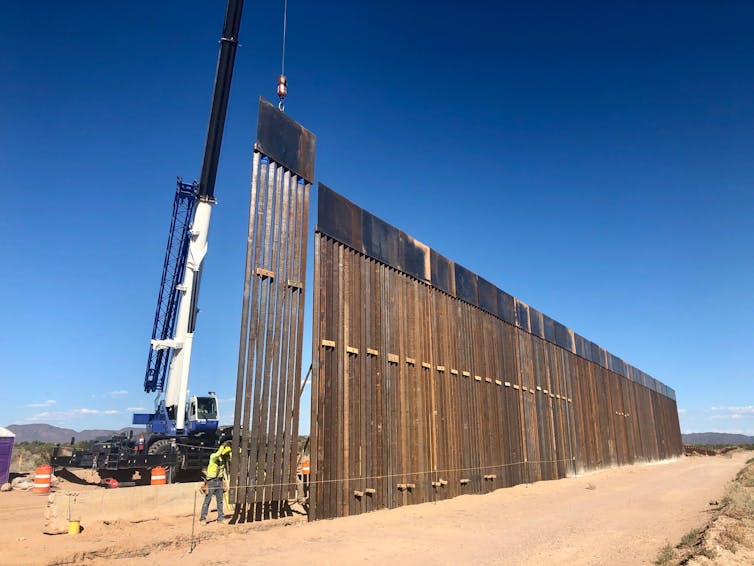From border security to climate change, national emergency declarations raise hard questions about p
Declaring an issue is a national emergency lets presidents act quickly and with few constraints. But once they get this kind of power, it's hard to take it back – and it can produce bad policies.

As wildfires, storms and other climate-driven disasters grow larger and more damaging, climate change is a major concern for many Democratic voters, who are in the midst of a primary fight that has come down to two major candidates: Bernie Sanders and Joe Biden. Both candidates say climate change would be one of their top priorities as president – but there’s an important difference between their approaches.
Sanders has pledged to declare climate change a national emergency and use executive power to lead “a ten-year, nationwide mobilization” to remake the U.S. economy.
Biden has also proposed an ambitious plan for “achieving a 100% clean energy economy,” but would rely on legislation and regulation to achieve many of his goals.
As a legal scholar specializing in energy and the environment, I believe that voters should consider this distinction carefully.
Presidential emergency powers could provide useful tools for addressing climate change, but taking this route sets an important precedent. As I see it, if presidents increasingly make free use of emergency powers to achieve policy goals, this approach could become the new normal – with a serious potential for abuse of power and ill-considered decisions.
Today, the border; tomorrow, the climate
President Trump declared a national emergency on border security on Feb. 15, 2019, after Congress refused to fund most of his US$5.7 billion request for border wall construction. As Trump’s intent became clear, Republican Sen. Marco Rubio warned that “tomorrow the national security emergency might be, you know, climate change.”
Rubio was right to take this possibility seriously. In my view, declaring a climate emergency would probably be legal, and would unlock provisions in many laws that authorize the president or subordinates to take specific actions under a national emergency declaration.
Like Trump, a Democratic president might use the power to divert military construction funds to other projects, such as renewable energy projects for military bases. A Democrat could also use trade measures – for example, restricting imports from countries with high carbon emissions, or imposing a carbon fee on goods from those countries to level the playing field.
Another potential action would be ordering businesses to produce certain goods. Just as the Trump administration reportedly has considered using a law dating from the 1950s to expand production of medical supplies for treating coronavirus patients, a Democrat could use the same power to boost battery or electrical vehicle production.
After declaring an emergency, the president could provide loan guarantees to critical industries in order to help finance goals such as expanding renewable energy production. Oil and gas leases on federal lands and in federal waters contain clauses that allow the Interior Department to suspend them during national emergencies. Declaring a national emergency would also enable the president to limit U.S. oil exports to other countries.
Is it legal?
Emergency powers are only available assuming climate change qualifies as an emergency. The law empowering presidents to declare national emergencies doesn’t define the term.
Among recent precedents, President Obama declared a cybersecurity emergency on April 1, 2015 that is still in effect, and Trump has declared that steel imports are an urgent threat to national security.
It’s not hard to make a case that climate change is an equally critical problem. Recent science indicates that major action will be needed in the next decade to hold warming below extreme levels. There’s also clear support for the idea that climate change is a major national security threat.
To date, courts have never overturned a presidential emergency declaration, and I believe a climate emergency seems unlikely to be an exception. Legal challenges to President Trump’s border security declaration so far have failed.

Frustration with gridlock
Emergency actions bypass bureaucracy and minimize the potential for litigation, compared to the cumbersome regulatory process. That makes them fast and decisive. They also place responsibility squarely on the president, which increases political accountability. There’s no question of who to blame if you don’t like the border wall – or emergency climate actions.
Unlike legislation, an emergency action does not have to move through Congress. And unlike federal regulations, there is no requirement for transparency or public comment, and less room for judicial oversight.
That can speed things up but it also makes major mistakes more likely. The internment of Japanese Americans during World War II is a vivid example.
In addition, once an emergency is declared, a president may be able to use emergency powers in laws that aren’t even related to that emergency. “Even if the crisis at hand is, say, a nationwide crop blight, the president may activate the law that allows the secretary of transportation to requisition any privately owned vessel at sea,” writes Elizabeth Goiten, director of the Brennan Center’s Liberty and National Security Program.

There’s no question that legislating is difficult and time-consuming. It requires the agreement of both houses of an increasingly polarized Congress. So long as the filibuster rule is in effect, it needs 60 votes in the Senate, which would require some Republican support even if Democrats regain a majority in the 2020 elections.
Americans seem increasingly frustrated by government’s inability to take bold action. If conventional means of policy change remain clogged, some people may find the national emergency approach all but irresistible.
Despite the appeal of breaking through gridlock, there are also real dangers to invoking emergency powers. Normalizing their use could make these expanded presidential powers hard to confine.
Congress has the power to nullify emergency declarations by passing a resolution of disapproval, but this has proved ineffective in practice. For instance, despite bipartisan support, Congress has failed to muster veto-proof margins for two resolutions overturning Trump’s border emergency, which the administration has used to divert billions of dollars to wall construction.
As Justice Robert Jackson wrote in Youngstown Sheet & Tube Company v. Sawyer – a famous 1952 Supreme Court decision in which the court held that President Truman did not have the constitutional authority to nationalize the U.S. steel industry during the Korean War – emergency powers “afford a ready pretext for usurpation,” and the potential for using those powers “can tend to kindle emergencies” to justify their use.
In my view, those risks may be worth taking only if all other avenues for dealing with an urgent problem like climate change are blocked. It remains to be seen whether that precondition will be met.
[You’re smart and curious about the world. So are The Conversation’s authors and editors. You can read us daily by subscribing to our newsletter.]
Daniel Farber does not work for, consult, own shares in or receive funding from any company or organization that would benefit from this article, and has disclosed no relevant affiliations beyond their academic appointment.
Read These Next
Where the wild things thrive: Finding and protecting nature’s climate change safe havens
Protecting places that are likely to remain cool and moist as global temperatures rise can save wildlife…
Billionaires with $1 salaries – and other legal tax dodges the ultrawealthy use to keep their riches
The richest Americans can largely avoid paying income and other taxes. A new book explains the history.
The US already faces a health care workforce shortage – immigration policy could make it worse
About 1 in 4 doctors practicing in the US were born abroad.





